1/48 Czech Master North American FJ-1 Fury restored
Blowtorches at Sea:
By 1944, the U.S. Navy was aware of what the USAAF and RAF were doing with the P-80 and Meteor projects, respectively, and knew as much as anyone did what was expected soon from the Germans. Having come up on the short end for underestimating the Japanese at the outset of the war, they were convinced the Japanese were much further along with jet development than in fact they were. With the Pacific War likely to involve an invasion of Japan and fighting into 1946, it seemed prudent to order some jets of their own. Being more conservative than the Air Force due to the difference in operating conditions, the first airplane ordered was the "halfway house" Ryan FR-1 "Fireball". This was followed shortly after with orders to McDonnell for the FH-1 "Phantom," to Chance Vought for the F6U "Pirate", and to North American for the FJ-1 "Fury."
None of these were completely successful. Adaptation of jet aircraft for service aboard aircraft carriers presented many difficulties: the airplanes were gas hogs, and all had tricycle landing gear, which had never been used aboard carries before. Additionally, the acceleration of the early jet engines left much to be desired, and it was not even certain a jet airplane could get off a carrier, assuming it could get aboard in the first place by any means other than a crane. There was going to be more to bringing jets to sea than merely commanding they be built.
North American's "Fury":
Three Fury prototypes were ordered January 1, 1945, followed by a production order for 100 on May 18 that was cut back to 30 following the end of the war in August. The first XFJ-1 flew November 27, 1946, and the first of the 30 production aircraft was delivered in October 1947.
The fat little fighter paid homage to its P-51 forbears in the wing shape and the nicely-tapered bubble canopy. Armed with six .50 caliber machine guns, the Fury used the Allison J-35A-2, which gave it a top speed of 547 mph at 9,000 ft - a healthy 80 mph better than the FH-1; landing speed of 121 mph was "hot" for an aircraft carrier. The low overall performance of the Fury prototypes was why North American was as happy as they were to discover the German swept wing research. This gave them reason to obtain an extra year for the development of the parallel USAAF project, the XP-86, which as a result would become the world-beating "Sabre."
The production FJ-1s served with VF-5A (later VF-51) at NAS North Island in San Diego, and were tested aboard the U.S.S. "Boxer" in March 1948. They proved just barely able to get off the deck unassisted, with the ship steaming full speed into a 20 knot wind. The airplane took nearly the entire flight deck to become airborne; jet fighters were going to need some extra oomph in the form of a catapult for takeoff, and this would change flight deck operations.
Two of the Furies set speed records, one from San Diego to San Francisco and one from San Diego to Seattle. Also, VF-5A's CO, CDR Bill Aurand, came in second in the 1948 Bendix Trophy Race with an average speed between Los Angeles and Cleveland of 436 mph.
By 1949, VF-51 had gone on to the F9F-2 Panther, and the surviving FJ-1s were turned over to the Naval Reserve at NRAB Oakland and NRAB Los Alamitos, California; NRAB Olathe, Kansas; and NRAB Dallas, Texas. They served until 1953, when the surviving airplanes were turned into instructional airframes. Two now survive in museums.
Model Restoration:
I built this model around 2002, using the Flightline Decs decals, the only aftermarket sheet ever produced for the FJ-1. Most importantly, it had decals for one of the FJ-1s operated by the Oakland, California, Naval Air Reserves from NAS Alameda. These airplanes were the subject of a photo session by famed aviation photographer (and my friend) the late Bill Larkins, which got a lot of use for advertising the Naval Air Reserves in the 1950s, which is where I first saw one of the photos and became interested in both the FJ-1 and that unit.
The model went into storage when we moved in 2015, and was rediscovered a couple months ago while cleaning out and straightening up in the garage.
As with all other Classic Airframes models using vacuform canopies, the canopy had yellowed - as you can see in the accompanying photo. This is due to the kind of plastic used, and is also the case with a new (to me) kit I picked up last fall. What to do? There was no chance of doing the model over with a different kit, since Flightline Decs is long gone.
Fortunately, it turns out that Kevin Martin, who has developed a business making resin upgrade parts for older kits, has a sideline of making replacement vacuform canopies with modern plastic that won't ever yellow. He has make masters for most all of the Classic Airframes kits. If you need a replacement canopy, they are $15 for two (one to replace the one you screw up). If he doesn't have the canopy you want and you send him the one you have, he'll make a master from it and send you the replacements. You can contact Kevin at (109ace-at-sbcglobal-dot-net). I can't say enough good for this service; I'm going to be able to restore my Fairey Battle with a new canopy..
Once I had the canopies, cutting the old one off the model and setting things up for the replacement was easy-peasy. I even had Gunze Sangyo Midnight Blue (the color used originally) to paint the replacement with. Once done, I realized the overall finish of the model had "declined" over the years. This was restored with a new coat of Micro-Scale Clear Gloss.
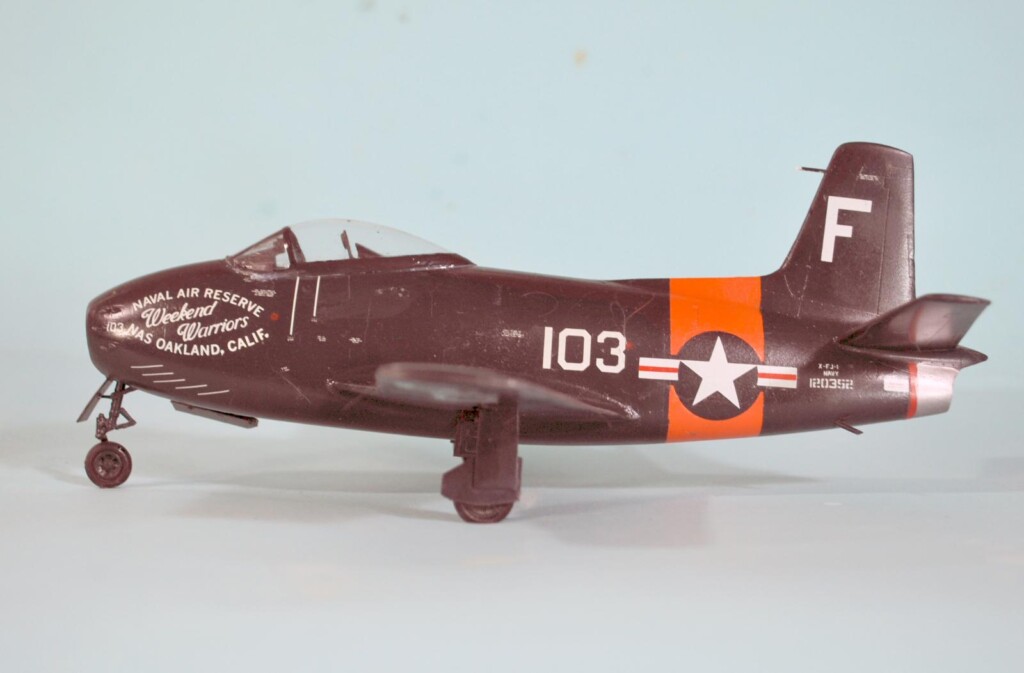
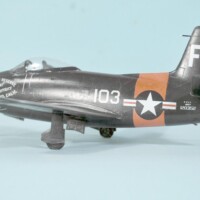
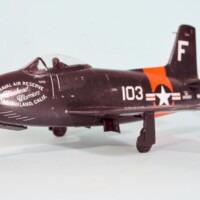
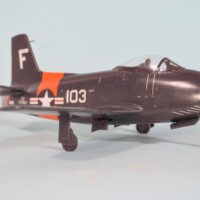

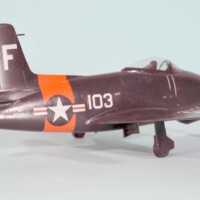
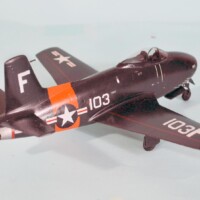
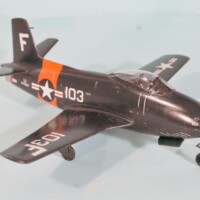
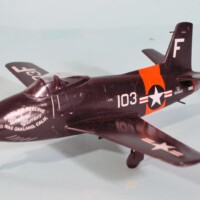
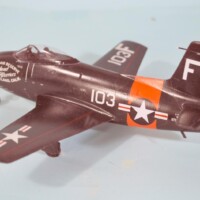
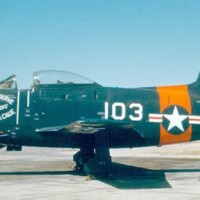
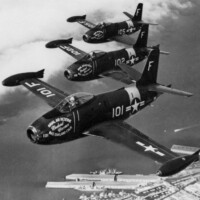
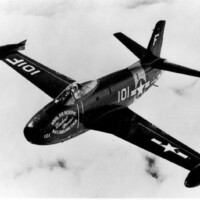
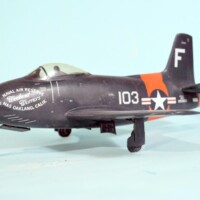
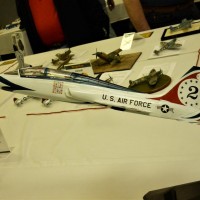
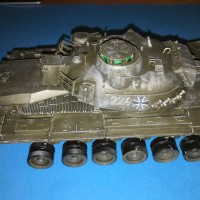

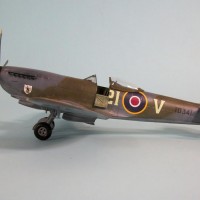
Great save, TC. Kit looks super.
Beauty
Adorably cute!
For those of us being totally confused about names and designations there is a good development table on Wikipedia showing the different lines in the Sabre/Fury family https://en.wikipedia.org/wiki/North_American_FJ-1_Fury
Nice restoration, Tom (@tcinla). Coincidentally, I was going through my garage and found a 1/72 unbuilt NA-57 in my garage and found a "tinted" canopy. I was trying to figure out some way to fix it and now you have provided the answer. Cheers
1 attached image. Click to enlarge.
Very cool aircraft, and a neat little model. Thanks for the heads up about Kevin Martin also. I have some unbuilt vintage kits that could benefit from his services.
I had just pulled out my 1/2 built Czech model of the the FJ-1 the other day and was wondering what to do with the yellow canopy. Thanks for the heads up on Kevin Martin.
I've had an interest in the plane for many years. When I was Ops. Director of the New England Air Museum in the 1980's, we had an FJ-1 in the collection. We picked it up in the 1960's, found abandoned at an airport here in the Northeast. The story was that the owner tried to sell it to a Latin American government and the State Dept. stepped in to stop it. The owner walked away and after several years we were able to get it.
The plane was Number 102 from VF-5a that set the speed record from San Diego to Seattle. We gave it a paint job, put it back in those markings and put it on display in our, then, new outdoor exhibit. After a few years, it was moved to storage to await a full restoration. It was traded out of the collection in the 1990's and is now at the Yanks Museum in Chino, CA. It looks to be fully restored and on display.
It looks very nice on display at Yanks. Here's a couple shots I took
2 attached images. Click to enlarge.
Looks awesome after all these years, Tom!
Nice work, Tom! That’s good to know that Kevin has Fairey Battle canopies. I need one for mine too.
A great restoration, Tom @tcinla
Great you were able to get a replacement canopy.
Nice to see an old model brought up to date.
Another obscure aircraft, nicely done! And many thanks for the tip on the canopies - I'm sure I'll need his services!
A wonderful model of this lesser known aircraft. Also a very interesting article.